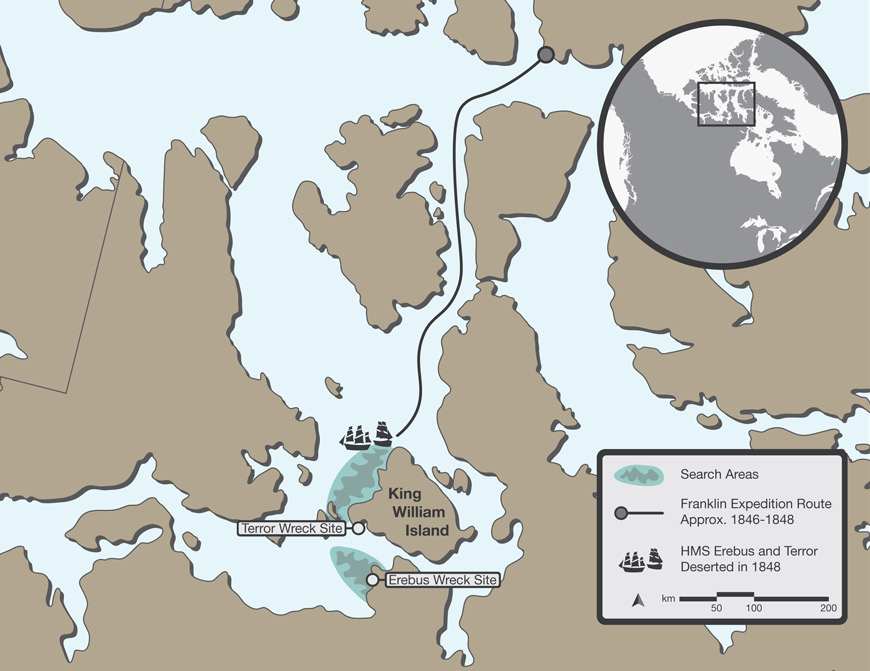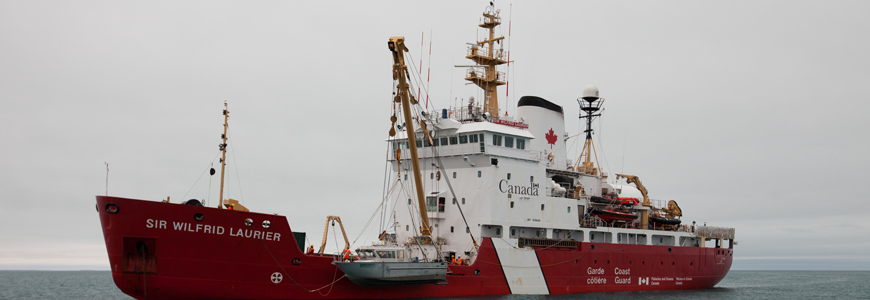
Searching for Franklin’s lost ships
Wrecks of HMS Erebus and HMS Terror National Historic Site
“We had always seen [the search] as a marathon, not a sprint.”
In 2008, Parks Canada underwater archaeologists embarked on a multi-year mission: a renewed search for the wrecks of HMS Erebus and HMS Terror. Every year brought new clues—and new challenges.
Parks Canada Missions
Over the years, the search for Sir John Franklin and his ships captured the public’s imagination—and helped map the Canadian Arctic. The ships were designated as a national historic site in 1992, long before the wrecks were located. In 1997, Canada signed a Memorandum of Understanding with Great Britain: if and when found, responsibility for the wrecks—and their recovery and contents—would fall to Canada.
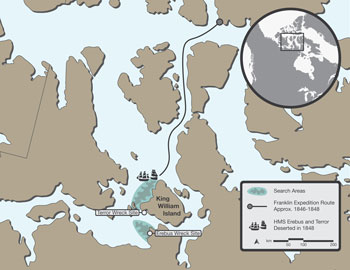
Click to enlarge
With this in mind, and as the federal government entity responsible for historical and archaeological site of national significance, Parks Canada took the lead in a new era of investigation. Background research included close consultation with Inuit, whose oral histories encompass Franklin and his ships.
In 2008, after considering all sources of information, Parks Canada’s Underwater Archaeology Team (UAT) determined two possible search areas: northern, near the ships’ abandonment point, and southern, where Inuit had said they had seen a ship. In August, they set out on what would become the last, great search for Franklin’s lost ships.
2008 - The initial search
Today, Arctic waters in the region where HMS Erebus and HMS Terror were lost are usually navigable in late August and early September. Search ships can only survey during this short window.
The rest of the year, Parks Canada investigators sift through many clues to determine how to best use the precious ice-free weeks. They decide where to search and what equipment to use. They coordinate the search and build partnerships. They talk with Inuit who live in the area and who have invaluable oral histories about Franklin’s journey.
The UAT collaborates with a number of organizations to search the largest possible area. Partners help with expert personnel, logistical support, and cutting-edge technologies.
After the search season ends, the UAT examines the data and plans the next year’s search.
In August 2008, the UAT and the Canadian Hydrographic Service set the stage for future search missions: they charted a 65-kilometre long corridor leading to what would become a main search area for HMS Erebus in Wilmot and Crampton Bay.
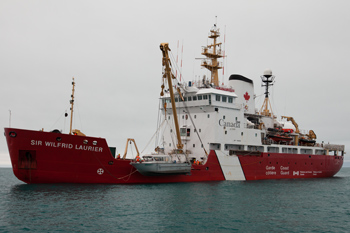
2009 - Unfavorable conditions
A planned second year of field work was ruled out when a shortage of available research ships made deployment impossible. The Canadian Coast Guard—an able and supportive member of the search effort—had committed ships to a number of research projects during the 2009 International Polar Year. Ice conditions were also uncooperative.
The UAT used the time to carry out work at other sites—and to plan for the 2010 field season.

2010 - Finding HMS Investigator
Parks Canada’s UAT, with support from the Canadian Hydrographic Service (CHS) and the Canadian Coast Guard, built on the work of the 2008 mission. CCGS Sir Wilfrid Laurier, again the key staging ship, safely travelled through the access corridor surveyed in 2008, and into the heart of the southern search area.
Over the course of six full days of surveying, the team made approximately 400,000 seafloor soundings and followed nearly 1,000 km of survey lines, scanning more than 150 square kilometres of seafloor in the process.
Immediately prior to deployment for the Franklin search, the UAT also located the wreck of an earlier Franklin search ship, HMS Investigator. This ship became stuck in ice in 1851 and in 1852; the crew abandoned it on the northeast shore of Banks Island.
2011 - Consulting Inuit oral histories
Victoria Strait and Alexandra Strait were ice-free for a period in August 2011. Parks Canada’s UAT and the CHS turned their attention to an area far to the north of the 2010 search. Inuit oral histories indicated one of Franklin’s ships had sunk in this area.
A team from the University of Victoria joined the search. Together, the searchers surveyed 140 kilometres of seafloor using bathymetric and side-scan sonar technology. They also used LiDAR technology. Land-based archaeologists looked for clues along 25 kilometres of shoreline on the Royal Geographical Society Islands.
2012 - Searching for clues
The addition of new partners—the Arctic Research Foundation and the Canadian Space Agency—greatly extended the duration and the search coverage of the 2012 mission.
Over the course of four weeks, the search team combed the seafloor around O’Reilly Island and farther north in Victoria Strait and Alexandra Strait. They used side-scan sonar, single-beam bathymetry, and multi-beam bathymetry. Operations were staged from both the returning CCGS Sir Wilfrid Laurier and first-timer Martin Bergmann.
Researchers from the University of Victoria deployed an autonomous underwater vehicle (AUV) in a trial run during the 2012 Franklin search. The AUV was shipped up to the Arctic in pieces for assembly. It carried a side-scan sonar that gathered acoustic waves to map the seafloor.
Helicopters delivered terrestrial archaeologists to key islands, where they searched for clues to the resting places of Erebus and Terror.
The 2012 mission charted 419 kilometres of seafloor, helping to make the area safer for the navigation of modern ships. The mission also ruled out the surveyed zones as the location of Franklin’s missing ships.
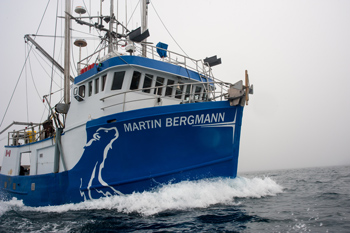
2013 - Expanding the search
The search intensified. For the first time, Parks Canada’s research and diving boat Investigator was sent north for the search, and was deployed from CCGS Sir Wilfrid Laurier.
The mission lasted almost six weeks and surveyed 486 kilometres of seafloor. The underwater team searched in two areas simultaneously: O’Reilly Island west of Adelaide Peninsula, and in Victoria Strait and Alexandra Strait. The Government of Nunavut’s land-based archaeological team concentrated their search along the shoreline of Erebus Bay.
Each year the team covered more ground. Every mission brought them closer to their goal.
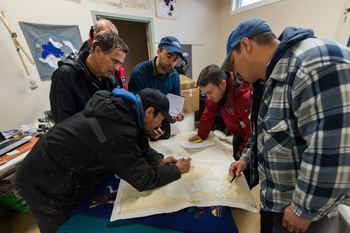
2014 - Finding HMS Erebus
Years of searching, planning, and staring at sonar screens all paid off. On September 1, a helicopter party from Sir Wilfrid Laurier led by Doug Stenton found a piece of rusted metal on an island in Wilmot and Crampton Bay. They also found a rounded piece of wood. Archaeologists soon identified the metal object as a davit pintle from a British Navy ship, and the wooden artifact as a hawse plug. On September 2, the UAT, working from its boat Investigator, shifted its search closer to the shore finds. UAT archaeologist Ryan Harris, who had led the search since 2008, was in front of the sonar screen—and watched with astonishment as the image of an intact ship sitting on the seafloor came into view.
They had found HMS Erebus.
The 2014 mission saw new partners: the Royal Canadian Geographical Society and the Royal Canadian Navy ship HMCS Kingston. Ice, always a concern in the Canadian Arctic, prevented Kingston from joining the search.
By the end of the season, the UAT and its partners had completed the sonar survey of a total of 1,601 square kilometres of seafloor. Most importantly, the mission had located HMS Erebus.
Read more about finding HMS Erebus.
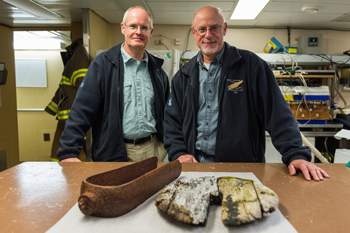

2015 - Planning the next moves
The UAT planned their next moves. First, how to best study and document HMS Erebus? And, of course, where was HMS Terror?
Follow the underwater archaeology team as they explore HMS Erebus.
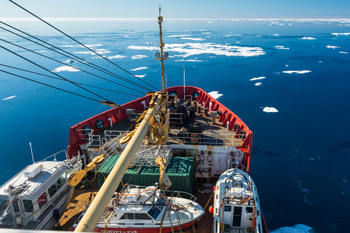
2016 - Finding HMS Terror and documenting HMS Erebus
UAT efforts were split in two: documenting HMS Erebus, and continuing the search for HMS Terror. The search concentrated in the northern area of Victoria Strait. CHS was once again part of the team, and the Royal Canadian Navy sent HMCS Shawinigan to assist.
An unexpected discovery, thanks to a tip from Gjoa Haven Inuk Samy Kogvik, changed everything. Research vessel Martin Bergmann, sonar deployed, sailed right over a sunken ship on its way to rendezvous with the main search team. Parks Canada archaeologists soon verified that the ship was HMS Terror
Archaeologists continue documenting HMS Erebus.
Follow archaeologists as they take a first look at HMS Terror.
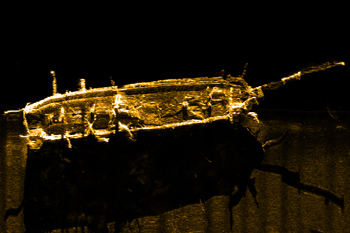
A joint effort for a joint cause
Many organizations came together during the Parks Canada search for HMS Erebus and HMS Terror. Their expertise and support were essential to the success of the search.
The missions weren’t just about finding the lost ships: charting the Arctic seafloor is invaluable for navigation now and into the future. Scientists also collected data useful for other researchers, especially for those tracking climate change.
The future of the ships
Locating HMS Erebus and HMS Terror is only the beginning. Documenting the wrecks and their contents—along with their journeys from where crew abandoned the ships to where the UAT found them—will keep Parks Canada and Inuit archaeologists, historians, and conservators busy for years. Finding the ships answers some questions, but poses many more.
Working collaboratively, Parks Canada and Inuit will protect and present the national historic site for future generations
The following organizations were project partners:
- Canadian Coast Guard
- Government of Nunavut
- Community of Gjoa Haven
- British Government
- Canadian Hydrographic Service, DFO
- Canadian Ice Service
- University of Victoria Ocean Technology Lab
- Arctic Research Foundation
- Canadian Space Agency
- Royal Canadian Navy
- Defence Research and Development Canada
- Operation QIMMIQ
Related information
Underwater ArchaeologyArtifacts
- Date modified :
